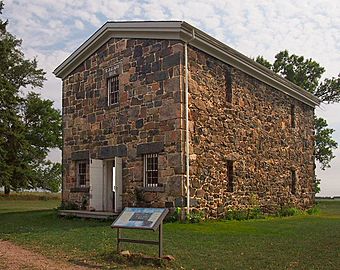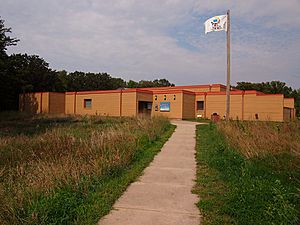Lower Sioux Agency facts for kids
Quick facts for kids |
|
|
Lower Sioux Agency
|
|

The Lower Sioux Agency warehouse from the northwest
|
|
| Location | 32469 County Hwy. 2, Sherman Township, Redwood County, Minnesota, USA |
|---|---|
| Nearest city | Morton, Minnesota |
| Area | 122.86 acres (49.72 ha) |
| Built | 1853–1862 |
| NRHP reference No. | 70000308 |
| Added to NRHP | 1970-09-22 |
The Lower Sioux Agency, also known as the Redwood Agency, was once an important government office for the Lower Sioux Indian Reservation in Redwood County, Minnesota. It is famous as the place where the Battle of Lower Sioux Agency happened on August 18, 1862. This battle was the first major fight of the Dakota War of 1862.
Today, the Lower Sioux Agency is a special historic site. The Lower Sioux Community works with the Minnesota Historical Society to manage it. In February 2021, the Lower Sioux Community took over ownership of half of the site. Visitors can explore an interpretive center, walk self-guided trails, and see a restored stone warehouse from 1861. This warehouse is listed on the National Register of Historic Places.
Contents
The Lower Sioux Agency's Beginnings
The United States government created the Lower Sioux Agency in 1853. Its purpose was to manage the new Lower Sioux Indian Reservation. This reservation was meant to be home for the Mdewakanton and Wahpekute bands of the Dakota people. They moved there after signing the 1851 Treaty of Mendota.
Challenges and Tensions in 1862
By August 1862, the Dakota people faced serious problems. Their treaty payments from the government were late, and they were running out of food. On August 15, 1862, the Lower Sioux asked the Agency staff for supplies.
Earlier that month, other Dakota bands had received food at the Upper Sioux Agency. However, Thomas J. Galbraith, the government agent in charge, refused to give food to the Lower Sioux. He said he could not give them food without payment from their delayed annuities.
At a meeting, Dakota leaders asked Andrew J. Myrick, a government trader, to sell them food on credit. Myrick's response was very harsh, suggesting they eat grass if they were hungry. This made the Dakota people feel even more desperate and angry.
The Start of the Dakota War
The treaty payments for the Dakota finally arrived in St. Paul, Minnesota, on August 16, 1862. They were brought to Fort Ridgely the next day. But it was too late to stop the growing conflict.
On August 17, 1862, four young Dakota men were hunting in Acton Township, Minnesota. During their trip, they took some eggs and killed five white settlers. Soon after, Dakota leaders held a meeting. Their leader, Little Crow, decided they should attack European-American settlements. The goal was to try and make the white settlers leave their lands.
The Attack on the Agency
On August 18, 1862, Little Crow led a group of warriors to attack the Lower Sioux Agency. They found Andrew Myrick trying to escape from a building. Myrick was killed, and his body was later found with grass in his mouth, a grim reminder of his earlier cruel words.
The warriors burned the buildings at the Lower Sioux Agency. This gave some settlers time to escape across the river using the Redwood Ferry.
Minnesota soldiers and a company from the 5th Minnesota Volunteer Infantry Regiment were sent to stop the fighting. However, they were defeated at the Battle of Redwood Ferry. Twenty-four soldiers, including their commander, Captain John Marsh, died in the battle. Throughout that day, Dakota war parties attacked many settlements in the Minnesota River Valley. Many settlers were killed, and towns like Milford, Leavenworth, and Sacred Heart were burned.
After the Conflict
After the Dakota War ended, most of the Sissetowan and Wahpeton bands were forced to leave Minnesota. They moved west to what was then Dakota Territory. Today, the Sisseton-Wahpeton Oyate is a recognized tribe with a reservation in South Dakota and North Dakota.
Visiting the Lower Sioux Agency Today
When you visit the Lower Sioux Agency, you can walk on self-guided trails around the historic grounds. The old granary from 1861 is the only original building still standing. Signs along the trails show where other important places once were, like the spot where the Redwood Ferry crossed the Minnesota River.
There are also gardens that show how the Dakota people traditionally farmed. You can compare these to the farming methods used by Euro-American settlers. It's a great way to learn about the history and cultures of the area.
Images for kids



